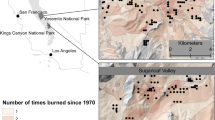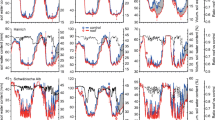Abstract
The aims of this study were to investigate spatial patterns and temporal changes in understorey vegetation at four forest catchments forming a depositional gradient. Inventories of the bottom and field layers were carried out in the 1990s and repeated after 5–14 years, depending on catchment. It was hypothesized that changes and patterns in ground vegetation would be related to changes and patterns in N and S deposition. The data were analyzed using Ellenberg indices and multivariate methods. All catchments showed temporal changes in species composition. Analyses of the bottom layer were confounded by a change of field staff, but after accounting for this observer effect, differences in species composition between the catchments remained. Within catchments, the changes in species composition were unrelated to N or S deposition. Relationships between environmental factors, expressed as Ellenberg indices, and compositional patterns differed between catchments although Ellenberg indices showed small temporal changes.




Similar content being viewed by others
References
Ahrends, A., C. Rahbek, M.T. Bulling, N.D. Burgess, P.J. Platts, J.C. Lovett, V.W. Kindemba, N. Owen, et al. 2011. Conservation and the botanist effect. Biological Conservation 144: 131–140.
Bache, B.W., I.T. Rosenqvist, P. Goldsmith, D. Fowler, J.G. Ogden, and K.A. Brown. 1984. Soil–water interactions [and discussion]. Philosophical Transactions of the Royal Society of London B, Biological Sciences 305: 393–407.
Bailey, R.G. 2009. Ecosystem geography: From ecoregions to sites. New York: Springer.
Barbier, S., F. Gosselin, and P. Balandier. 2008. Influence of tree species on understory vegetation diversity and mechanisms involved—a critical review for temperate and boreal forests. Forest Ecology and Management 254: 1–15.
Benedictow, A., H. Fagerli, M. Gauss, J.E. Jonson, Á. Nyíri, D. Simpson, S. Tsyro, A. Valdebenito, et al. 2009. Transboundary acidification, eutrophication and ground level ozone in Europe in 2007. EMEP Status Report 2009. Norwegian Meteorological Institute.
Bobbink, R., M. Ashmore, S. Braun, and W. Flückiger. 2003. Empirical nitrogen critical loads for natural and semi-natural ecosystems: 2002 update. Background document for expert workshop on empirical critical loads for nitrogen on (semi-) natural ecosystems. In Empirical critical loads for nitrogen, ed. B. Achermann and R. Bobbink, 43–170. Berne: Swiss Agency for the Environment, Forests and Landscape.
Bobbink, R., K. Hicks, J. Galloway, T. Spranger, R. Alkemade, M. Ashmore, M. Bustamante, S. Cinderby, et al. 2010. Global assessment of nitrogen deposition effects on terrestrial plant diversity: A synthesis. Ecological Applications 20: 30–59.
Brown, D.H., and J.W. Bates. 1990. Bryophytes and nutrient cycling. Botanical Journal of the Linnean Society 104: 129–147.
Cornwell, W.K., and P.J. Grubb. 2003. Regional and local patterns in plant species richness with respect to resource availability. Oikos 100: 417–428.
Diekmann, M. 2003. Species indicator values as an important tool in applied plant ecology—a review. Basic and Applied Ecology 4: 493–506.
Ellenberg, H., H.E. Weber, R. Düll, V. Wirth, W. Werner, and D. Paulissen. 1991. Zeigerwerte von Pflanzen in Mitteleuropa. Scripta Geobotanica 18: 1–248 (in German).
Erisman, J.W., and W. de Vries. 2000. Nitrogen deposition and effects on European forests. Environmental Reviews 8: 65–93.
Geburek, T., K. Robitschek, and N. Milasowszky. 2008. A tree of many faces: Why are there different crown types in Norway spruce (Picea abies [L.] Karst.)? Flora—Morphology, Distribution, Functional Ecology of Plants 203: 126–133.
Gilliam, F.S. 2006. Response of the herbaceous layer of forest ecosystems to excess nitrogen deposition. Journal of Ecology 94: 1176–1191.
Grandin, U. 2004. Dynamics of understory vegetation in boreal forests: Experiences from Swedish integrated monitoring site. Forest Ecology and Management 195: 45–55.
Grandin, U. 2011. Epiphytic algae and lichens as a proxy for N and S deposition—a long-term study along a deposition gradient in Sweden. Ambio. doi:10.1007/s13280-011-0206-9.
Greenwood, J., and D. Durand. 1955. The distribution of length and components of the sum of n random unit vectors. The Annals of Mathematical Statistics 26: 233–246.
Hytteborn, H., and T. Verwijst. 2011. The importance of gaps and dwarf trees in the regeneration of Swedish spruce forests: The origin and content of Sernander’s (1936) gap dynamics theory. Scandinavian Journal of Forest Research 26: 3–16.
Jalkanen, R., and B. Konocpka. 1998. Snow-packing as a potential harmful factor on Picea abies, Pinus sylvestris and Betula pubescens at high altitude in northern Finland. European Journal of Forest Pathology 28: 373–382.
JMP, 2010. Version 9. SAS Institute Inc., Cary.
Köchy, M., and S. Bråkenhielm. 2008. Separation of effects of moderate N deposition from natural change in ground vegetation of forests and bogs. Forest Ecology and Management 255: 1654–1663.
Lee, J.A. 1998. Unintentional experiments with terrestrial ecosystems: Ecological effects of sulphur and nitrogen pollutants. Journal of Ecology 86: 1–12.
Liska, J., and T. Herben. 2008. Long-term changes of epiphytic lichen species composition over landscape gradients: An 18 year time series. The Lichenologist 40: 437–448.
Magurran, A.E. 2004. Measuring biological diversity. Oxford: Blackwell Publishing.
Magurran, A.E., S.R. Baillie, S.T. Buckland, J.M. Dick, D.A. Elston, E.M. Scott, R.I. Smith, P.J. Somerfield, et al. 2010. Long-term datasets in biodiversity research and monitoring: Assessing change in ecological communities through time. Trends in Ecology & Evolution 25: 574–582.
Messier, C., J. Posada, I. Aubin, and M. Beaudet. 2009. Functional relationships between old-growth forest canopies, understorey light and vegetation dynamics. In Old-growth forests, eds. C. Wirth, G. Gleixner, and M. Heimann, 115–139. Berlin: Springer.
Milberg, P., J. Bergstedt, J. Fridman, G. Odell, and L. Westerberg. 2008. Observer bias and random variation in vegetation monitoring data. Journal of Vegetation Science 19: 633–644.
Nilsson, I.N., and S.G. Nilsson. 1985. Experimental estimates of census efficiency and pseudoturnover on islands: Error trend and between-observer variation when recording vascular plants. Journal of Ecology 73: 65–70.
Nordin, A., J. Strengbom, J. Witzell, T. Näsholm, L. Ericson, et al. 2005. Nitrogen deposition and the biodiversity of boreal forests: Implications for the nitrogen critical load. Ambio 34: 20–24.
Økland, R.H., and O. Eilertsen. 1996. Dynamics of understory vegetation in an old-growth boreal coniferous forest, 1988–1993. Journal of Vegetation Science 7: 747–762.
Oksanen, J. 2006. Vegan: R functions for vegetation ecologists. http://cc.oulu.fi/~jarioksa/softhelp/vegan.html. Accessed 28 Oct 2011.
Paillet, Y., L. Bergès, J. Hjältén, P. Ódor, C. Avon, M. Bernhardt-Römermann, R.-J. Bijlsma, L. de Bruyn, et al. 2010. Biodiversity differences between managed and unmanaged forests: Meta-analysis of species richness in Europe. Conservation Biology 24: 101–112.
R Development Core Team. 2010. R: A language and environment for statistical computing, R Foundation for Statistical Computing. Vienna: R Development Core Team. http://www.R-project.org. Accessed 28 Oct 2011.
Reis, S., R. Pinder, M. Zhang, G. Lijie, and M. Sutton. 2009. Reactive nitrogen in atmospheric emission inventories. Atmospheric Chemistry and Physics 9: 7657–7677.
Salemaa, M., J. Derome, and P. Nöjd. 2008. Response of boreal forest vegetation to the fertility status of the organic layer along a climatic gradient. Boreal Environment Research 13: 48–66.
Sang, W., and F. Bai. 2009. Vascular diversity patterns of forest ecosystem before and after a 43-year interval under changing climate conditions in the Changbaishan Nature Reserve, northeastern China. Plant Ecology 201: 115–130.
Sjöberg, K., A. Svensson, G. Pihl Karlsson, and H. Blomgren. 2006. Nationell miljöövervakning inom EMEP och luft- och nederbördskemiska nätet 2004 & 2005. Stockholm: IVL Svenska Miljöinstitutet (In Swedish).
Sjörs, H. 1956. Nordisk växtgeografi. Stockholm: Alb. Bonniers boktryckeri. (In Swedish).
Strengbom, J., A. Nordin, T. Näsholm, and L. Ericson. 2001. Slow recovery of boreal forest ecosystem following decreased nitrogen input. Functional Ecology 15: 451–457.
van Dobben, H., and W. de Vries. 2010. Relation between forest vegetation, atmospheric deposition and site conditions at regional and European scales. Environmental Pollution 158: 921–933.
Vittoz, P., and A. Guisan. 2007. How reliable is the monitoring of permanent vegetation plots? A test with multiple observers. Journal of Vegetation Science 18: 413–422.
Zar, J.H. 1999. Biostatistical analysis. Upper Saddle River: Prentice-Hall.
Zechmeister, H.G., T. Dirnböck, K. Hülber, and M. Mirtl. 2007. Assessing airborne pollution effects on bryophytes—lessons learned through long-term integrated monitoring in Austria. Environmental Pollution 147: 696–705.
Acknowledgments
Tommy Pettersson is thanked for his zealous and careful field work. Richard K. Johnson and anonymous reviewers provided valuable comments on the manuscript. The monitoring program and this study were financed by the Swedish Environmental Protection Agency.
Author information
Authors and Affiliations
Corresponding author
Rights and permissions
About this article
Cite this article
Grandin, U. Understorey Vegetation Stability and Dynamics in Unmanaged Boreal Forests Along a Deposition Gradient in Sweden. AMBIO 40, 867–877 (2011). https://doi.org/10.1007/s13280-011-0206-9
Published:
Issue Date:
DOI: https://doi.org/10.1007/s13280-011-0206-9




